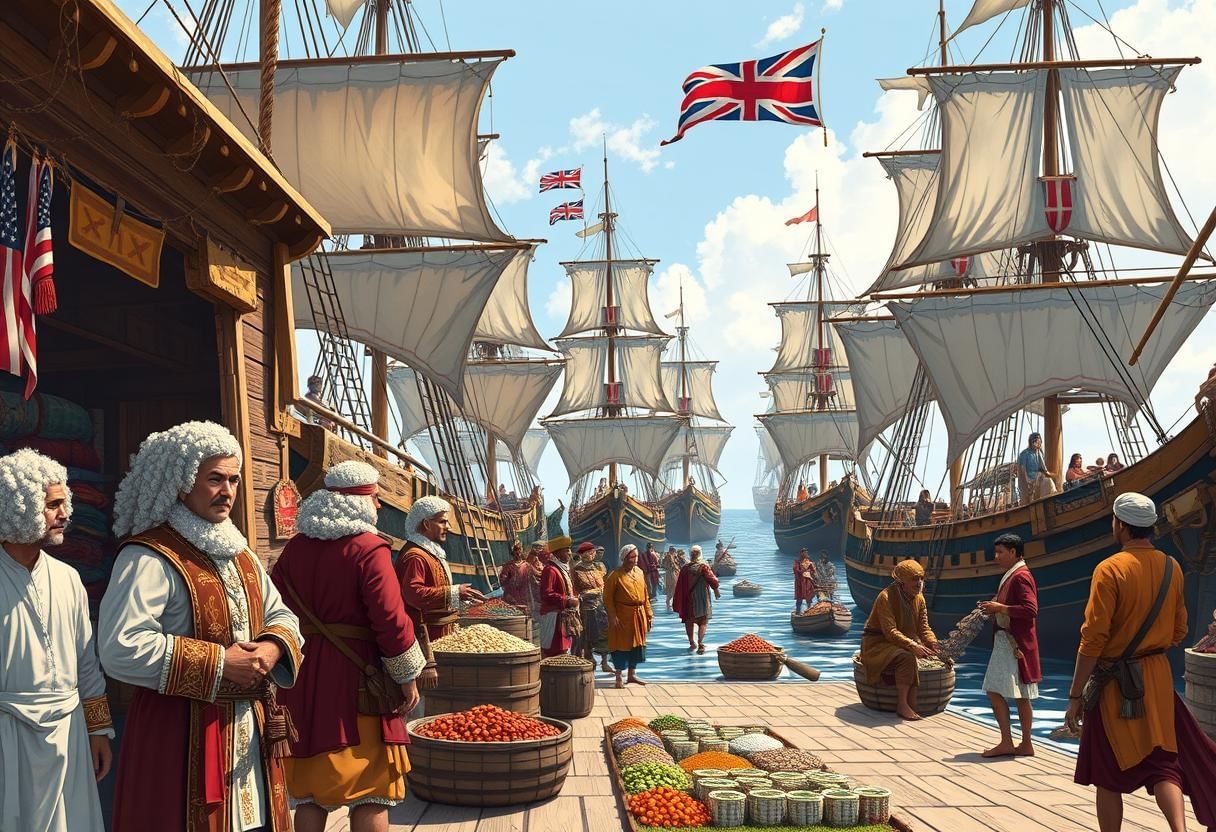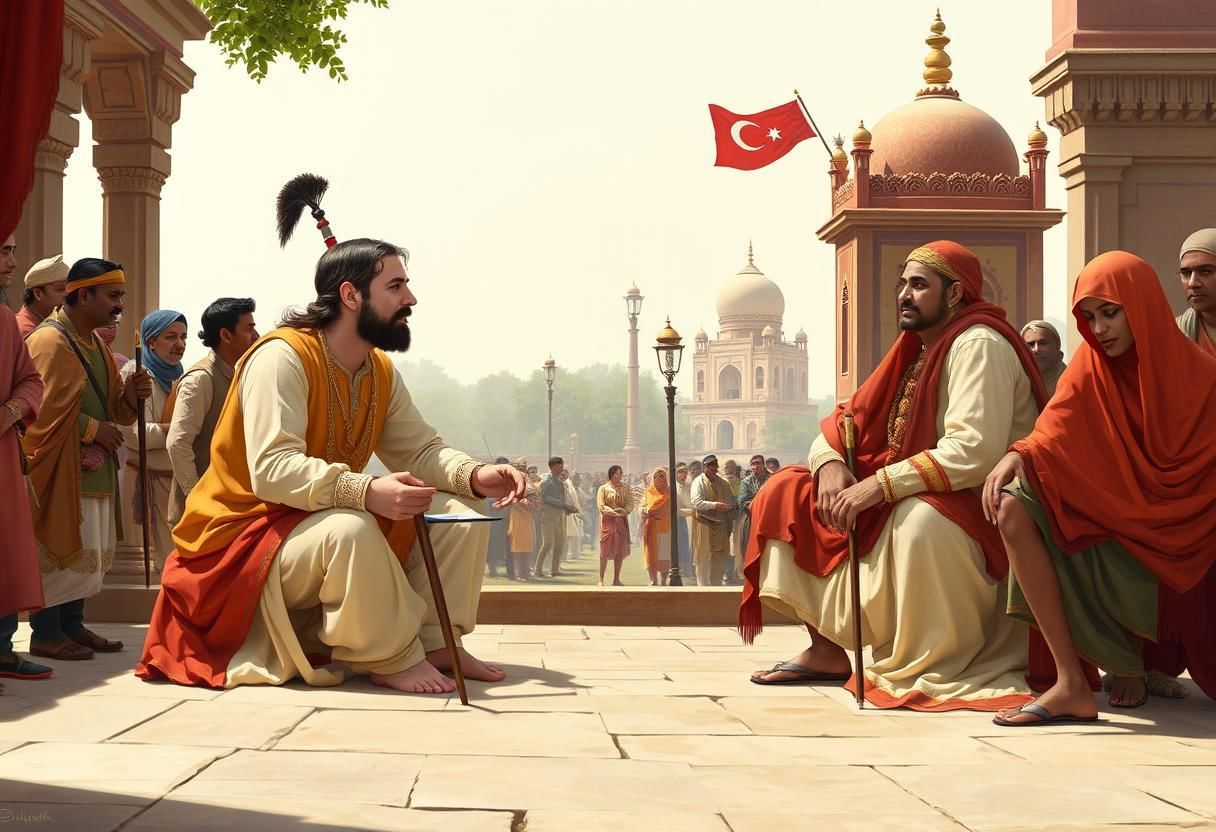UPSC Exam > UPSC Notes > History for UPSC CSE > The English & The French: Beginning of European Commerce
The English & The French: Beginning of European Commerce | History for UPSC CSE PDF Download
The English and The French
The English
- The victory of the English over the Spanish armada and the reports of India’s wealth aroused in the minds of the English a strong desire to establish trade relations with India.
- It was on 31st December 1600 A.D., that the first momentous step was taken in respect of England’s trade in the East by the incorporation, under a charter from queen Elizabeth, of the East India company under its first title of “The Governor and company of Merchants of London Trading into the East Indies”.
- Monopoly of trade in the East was granted to it for fifteen years.
- On the south-east coast of India the English had started a factory in 1611 A.D. at Masulipatam.
 East India Company
East India Company
Points To Be Remembered
|
- Their position was improved by the ‘Golden farman’ granted to them by the sultan of Golcunda in 1632 A.D. Francis Day, who was responsible for opening the factory at Armagon, obtained permission from the ruler of Chandragiri, to build a fortified factory at Madras (Fort St. George).
- In Bengal the company wanted to have fortified settlement at Hoogly so that force could be used if necessary.
- The mission of William Hedges, the first governor and agent of the English company in Bengal in 1682 A.D. to Shayista Khan proved to be of no avail.
- In 1686 A.D. the English captured the imperial forts of Thana, Malded Hijili on the east of the Midnapore district, and stormed the Mughal fortification at Balasore.
- But the English were forced to leave Hoogly and to retire to a place at the mouth of the river. Job
Charnock, their agent, opened negotiations for permission to returned to Sutanauti.
- After the conclusion of peace between the Company and the Mughal governmor in 1690 A.D. Job Charnock came back to Bengal as agent and founded the city of Calcutta and built Fort William.
- The most important event after the death of Aurangzeb was the diplomatic mission led by Jhon Surman in 1715 A.D. to the court of Mughal emperor Farrukhsiyar, resulting in the grant of three famous farmans.
- The farmans gave the Company many valuable privileges. In Bengal it exempted the Company’s imports and exports from additional custom duties excepting the annual payment of Rs. 3000.
- The Company was allowed to rent additional land around Calcutta. At Surat, the Company was exempted from the levy of all duties for its exports and imports in lieu of an annual payment of Rs. 10,000, and the coins of the Company (minted at Bombay) were to have currency throughout the Mughal empire.
- Thomas Pitt, governor of Madras obtained from the Nawab of Karnataka a grant of five village near Madras in 1708 A.D.
 Calcutta Fort William
Calcutta Fort William
The French
- It was in 1664 A.D. that Colbert, the minister of Louis XIV, organized the French East India company.
- The company started the work and captured the islands of Bourbon and Mauritius in the Indian Ocean.
- In 1667 A.D. an expedition was sent under. Francios Caron, who established first French factory in India at Surat.
- In 1669 A.D. Marcara founded another French factory at Masulipatam by securing a patent from the sultan of Golcunda in 1673 A.D.
- Francois Martin obtained from Sher Khan Lodi, governor of Valikondapuram, a site for a factory.
- Thus “began in modest fashion the historic role of Pondicherry”. In Bengal, the French laid the foundation of their famous settlement of Chandannagar in 1690 A.D. on a site granted to them by Shayista Khan.
- The Dutch occupied Pondicherry in 1693 A.D. It was restored to the French by the Treary of Ryswick concluded in September 1697 A.D.
- There was an unfavourable turn in the position of the French in India after the war of Spanish succession had broken out.
- They had to abandon their factories at Surat, Masulipatam and Bautam by the beginning of the 18th century.
- Further deterioration came after the death of Francois Martin on 31st December 1706 A.D. There was again a period of progress under the two wise and active governors, Lenoir and Dumas, between 1720 and 1742 A.D. The French captured Mauritius in 1721 A.D., and Masulipatam, Calicut, Mahe and Yanam in the next two years. They had only commercial objectives in view till now.
- Political motives appeared after 1740 with Dupleix’s ambition to establish a French empire in India.
 French East India Company
French East India Company
Causes of the Rivalry of the French and the English
- The commercial and political interest of the English and the French brought them in constant clash with each other.
- The French Governors in the East wanted to expel the English from the Indies.
- In Europe also the English and the French were rivals for power. Their fight for power in Europe was sure to react on their relations in India.
- The strength of the English and the French was on trial during the second Hundred Years’ War (1689-1815).
- Many important issues were involved in this (a) the question of leadership in India, (b) the issue as to which form of religion and government should prevail, (c) the third issue was as to who should control the seas.
- The power which was supreme in the sea was to enjoy the best fruits of commerce and the commands of the newly discovered lands.
- The French leaders and commanders were determined to establish French empire in India.
- The war of the Austrian succession broke out in Europe in 1740. England and France took opposite sides, though they formally declared war against each other only in 1744.
- As a result of this, war broke out between the two nations in India also. So the war of the Austrian succession served as the immediate cause of the First Carnatic War.
The document The English & The French: Beginning of European Commerce | History for UPSC CSE is a part of the UPSC Course History for UPSC CSE.
All you need of UPSC at this link: UPSC
|
216 videos|855 docs|219 tests
|
FAQs on The English & The French: Beginning of European Commerce - History for UPSC CSE
| 1. What was the significance of the English and French in the beginning of European commerce? |  |
Ans. The English and French played a significant role in the beginning of European commerce as they were among the first nations to establish extensive trading networks and colonies around the world. Their exploration and trade expeditions helped pave the way for the expansion of European commerce globally.
| 2. How did the English and French contribute to the growth of European commerce? |  |
Ans. The English and French contributed to the growth of European commerce through their maritime explorations, establishment of colonies, and development of trading networks. They sought new trade routes, established settlements, and engaged in a variety of trade activities, such as the exchange of goods, resources, and cultural influences with other regions.
| 3. What were some of the key trade routes established by the English and French during the early days of European commerce? |  |
Ans. The English and French established several key trade routes during the early days of European commerce. Some notable examples include the English East India Company's trade route to India and Southeast Asia, the French colonial trade routes to the Americas, Africa, and the Indian Ocean, and the triangular trade route between Europe, Africa, and the Americas.
| 4. How did the English and French colonial pursuits impact European commerce? |  |
Ans. The English and French colonial pursuits had a significant impact on European commerce. Their colonies provided valuable resources, such as raw materials and precious metals, and served as lucrative markets for European goods. The establishment of colonies also led to the development of a global trading system, where goods could be exchanged across vast distances.
| 5. What were some of the economic and cultural exchanges between the English, French, and other regions during the early stages of European commerce? |  |
Ans. The early stages of European commerce saw numerous economic and cultural exchanges between the English, French, and other regions. These exchanges included the introduction of new crops and products, such as tobacco and coffee, from the Americas to Europe, as well as the adoption of European technologies and practices in the colonies. Additionally, cultural influences and interactions shaped both European and non-European societies, leading to the exchange of ideas, languages, and customs.
Related Searches
















